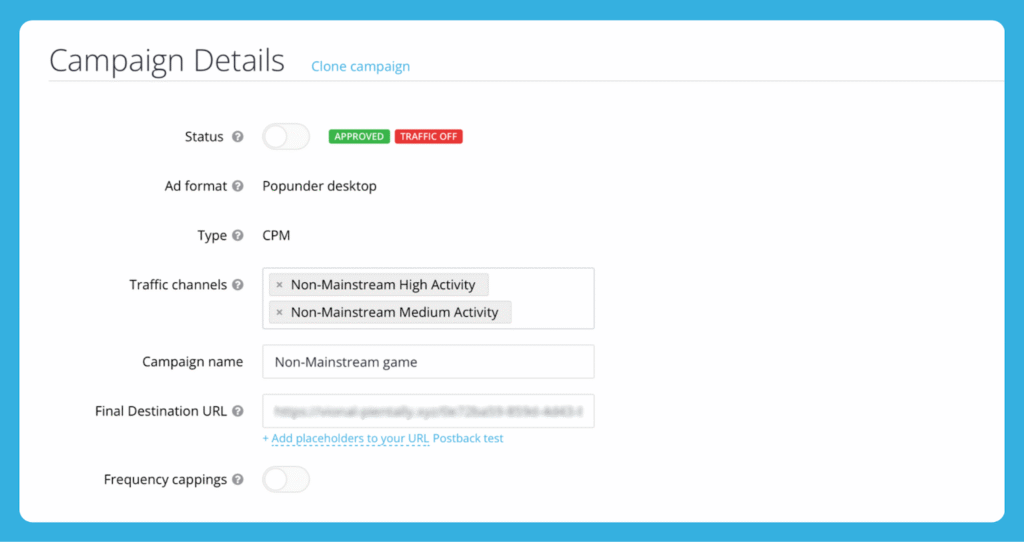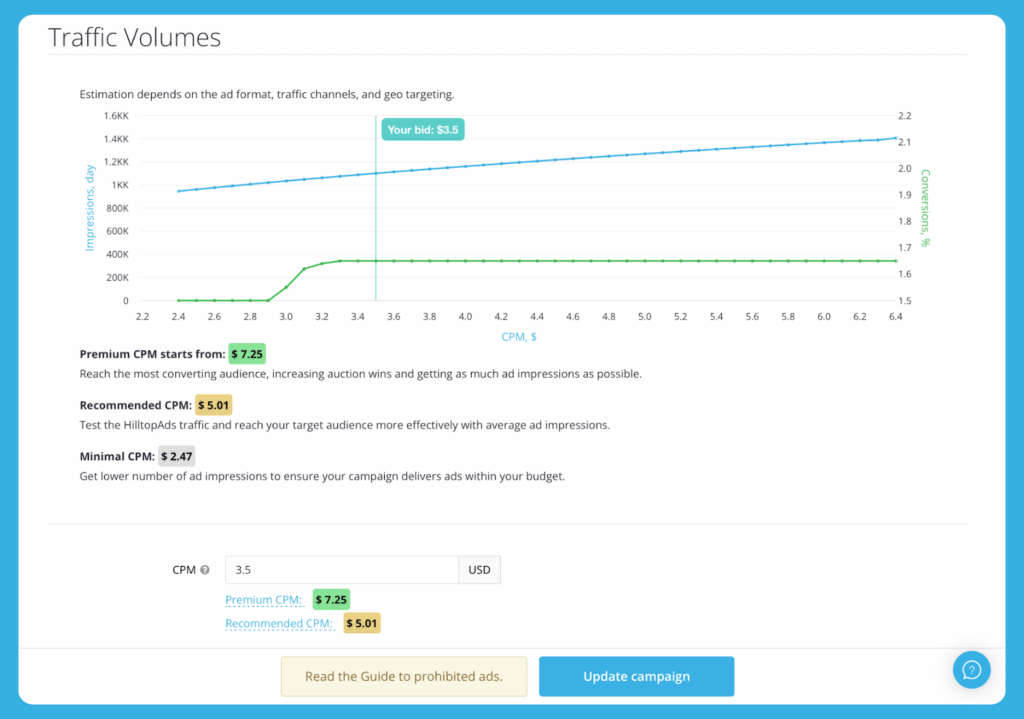Many affiliates jump into the non-mainstream gaming niche hoping for quick profits but most get lost in the crowd and waste their budgets. In this case study, we show how one marketer reached a 64% ROI in just seven days with a HilltopAds Popunder campaign, smart targeting, and automated optimization. You’ll discover how to pick the right GEOs, filters, and ad formats to turn this “oversaturated” niche into a steady and profitable income stream.

For affiliate marketers, few niches spark as much excitement (and revenue) as non-mainstream gaming. We’re talking about a vertical so lucrative it’s practically become the industry’s open secret.
Sure, skeptics will tell you the space is oversaturated – after all, any newbie can jump in, and many do. But here’s the reality: this “non-mainstream” niche is evergreen, and its audience is as hungry as ever.

Promote your non-mainstream offers
with the best Popunder ad network HilltopAds!
Today’s case study dives into exactly why non-mainstream games remain a consistent cash cow and how our partner managed to ride this wave to success.
Non-mainstream is brutally competitive. Win with original landers and target real gamers – not broad non-mainstream traffic. That’s your edge.
Non-mainstream Gaming as an Evergreen Niche
There’s a common belief that the non-mainstream gaming vertical is oversaturated: the low barrier to entry means countless affiliates are competing for the same clicks.
So why do many media buyers still choose this niche (including our partner whose case we’re examining)?
First of all, non-mainstream games – like any other “non-mainstream” products – can be considered an evergreen vertical. Enduring demand meets adaptable formats – interest isn’t going anywhere.
Some 15-20 years ago, it seemed like every third website on the internet was dedicated to dating or explicit content. Now the web has become much more diverse.
Nonetheless, the audience’s interest in non-mainstream-oriented material remains as strong as ever; it’s just now present in a wider variety of formats. Non-mainstream games fit right into this trend: such games always find their audience.
Read our step-by-step guide on how to promote OnlyFans pages with ad networks in 2025:

How to Promote Your OnlyFans with Ad Networks in 2025
Statistics on Non-mainstream Games
To gauge the size of this niche, let’s look at a few numbers. The global market for non-mainstream games was estimated at approximately $9.3 billion back in 2020. By some forecasts, it will grow about +8.6% annually through 2027.
Even though non-mainstream games make up only a small share of the overall gaming industry, up to 80% of offers in this vertical are promoted through affiliate marketing. This means advertisers in this space rely heavily on affiliates, leading to especially close cooperation between them.
Stay on the right side of policy. Regulations vary, and some regions block non-mainstream altogether. Build funnels that are compliant by design.
As for geography, data from Pornhub shows that the bulk of non-mainstream gaming traffic comes from developed countries. The top five are Germany, France, Italy, Spain, and the United States.
In other words, Western audiences are particularly active consumers of non-mainstream content in game form, which creates opportunities to grow profit in those regions.
Best‑performing regions? Tier‑1 is always in play – and don’t sleep on parts of Asia. Just match the offer to real purchasing power.

Launch your non-mainstream campaign
with the HilltopAds ad network.
Geography and Audience Growth
When promoting gaming offers, it’s important to consider geography. The United States still leads in total video game market size – expected to generate around $78 billion in revenue in 2024.
Other large markets are found in Europe and Asia (for example, China, Japan, and South Korea), though in the context of non-mainstream gaming the main competition takes place among Western regions.
Demand for games is growing on both sides of the Atlantic, as well as around the globe. Gaming has moved from a teen niche to a mainstream habit.
In fact, there are over 3.3 billion gamers worldwide, meaning nearly half of the planet’s population plays video games in one form or another.
For comparison, back in 2015 there were only about 2.0 billion gamers; the industry attracted approximately 1.3 billion new players in less than a decade.
In the United States alone, 61% of the population (around 190 million people) plays video games at least one hour per week.
Gaming’s penetration into all segments of society is clear: from casual mobile players to hardcore PC gamers and even professional eSports athletes, the industry has seen explosive growth in recent years.
Just look at Twitch – the largest game streaming platform – where roughly 20.9 billion hours of content were watched over 2024. That stat vividly demonstrates the sheer scale and engagement of today’s gaming audience.
Why U.S. desktop and Windows? Simple: more volume on Windows, a better audience fit for non-mainstream games, and relatively few Mac gamers in this niche.
Audience Diversity: Gender and Engagement
Games today appeal to everyone – the stereotype that only young men are gamers is long outdated. Women now comprise nearly half of the gaming audience.
In the U.S., about 46–47% of players are female and 53–54% male, and globally the ratio is estimated at about 45% women to 55% men.
According to a 2022 survey, roughly 6% of women and 9% of men in the U.S. qualify as “hardcore” gamers (spending 13-24 hours a week playing).
Meanwhile, only about 30% of women and 25% of men said they never play video games – meaning the vast majority are involved in gaming culture to some extent. In short, gaming has truly become mainstream entertainment for all genders and ages.
More on the Gaming Industry
Twenty years ago, PC games reigned almost unchallenged, and consoles largely stayed in the shadows (with a few regional exceptions in Asia).
Now it’s a different story: mobile games dominate by sheer number of players. As of 2024, the player base on mobile far exceeds other platforms:
- Mobile devices: ~2.85 billion players
- Personal computers: ~908 million players
- Consoles: ~630 million players
Smartphones have thus reached a much wider audience than traditional gaming hardware. In terms of revenue, the mobile segment also leads, generating roughly 49% (around $92 billion) of global gaming revenue in 2024.
Consoles account for about 28% (~$51 billion), and PC games roughly 23% (~$43 billion). The reason for mobile’s dominance is simple: it’s extremely easy to start playing on a phone – most people own a smartphone, and mobile titles are often free-to-play or freemium.
Likewise, browser games on PC have virtually no barrier to entry; you just open a web page and jump straight into the game.
Non-mainstream games tend to convert better on desktop. The experience is simply more comfortable there – and popunders shine because they drop users right into the game.
Today, practically everyone plays video games, even folks far removed from the classic “gamer” stereotype. That doesn’t mean the big-budget titles are fading away – major AAA projects on PC and consoles still draw massive crowds and revenues.
Mobile apps have captured the broad mass market, but individual blockbuster releases on PC/console often out-earn mobile hits.
Remember how ten years ago everyone (and their mom) got hooked on simple phone games? Even now, huge releases like Cyberpunk 2077 or the annual Call of Duty installments bring in billions for their companies.
For the largest console platforms and AAA games, affiliate (CPA) marketing isn’t a significant factor – those giants lean on brand power and enormous advertising budgets.
But for niche gaming products (mobile F2P titles, indie projects, gaming services) and especially for non-mainstream games, affiliate marketing has become one of the key user acquisition channels.
The non-mainstream gaming niche is effectively built on affiliate programs, since mainstream ad networks like Google AdSense won’t work with non-mainstream content.
This means affiliate marketers have carved out their own turf where they can effectively promote gaming products that have stayed off the radar of the industry’s big players.
New to the vertical? You can start – but have a healthy budget. If funds are middling, begin with Tier‑2 countries before you go after the most expensive GEOs.
It’s also worth noting that the COVID-19 pandemic gave the gaming industry a massive boost. In 2020, when billions of people were stuck at home, the global gamer count jumped to about 2.8 billion – many discovered gaming during quarantine.
That momentum hasn’t faded: even after returning to normal life, people haven’t lost their appetite for games. Engagement remains high; for example, roughly 60% of adults in the U.S. still play video games weekly.
The industry continues to break its own revenue records every year. The global gaming market already surpassed $187 billion in 2024 and is on track to exceed $200 billion by 2025, reinforcing video games’ status as one of the leading sectors in entertainment.
Want to start advertising with HilltopAds? Read the full guide from our real advertiser: how to start, how to track, how to optimize.
Watch for bot traffic on ‘easy’ flows like free regs – it can creep in fast. And avoid shotgun testing across everything; mass testing just torches budgets.

Sign up with HilltopAds right now
and get a high ROI on your non-mainstream campaigns.
Types of Non-mainstream Gaming offers
Now let’s consider the main types of offers in the non-mainstream gaming vertical and what options are available to affiliates. Despite the high competition, the range of offers is quite broad:
Desktop games (PC downloadable)
These are projects that require the user to install a client on their PC (excluding the major AAA titles). They usually run on desktop computers, though oftentimes there’s a mobile version available as a separate app.
Browser games (PC/Mobile browser)
Games that run directly in a web browser on PC or mobile, with no need to install anything. These offers are currently in big demand and are relatively straightforward to work with.
However, because competition is intense, it’s not recommended for beginners to start with offers focused on mobile games.
Mobile apps (Android app)
Games from independent developers or small studios, created without the backing of large publishers. These titles are growing in popularity, and even well-known streamers are increasingly giving them attention.
Since classic promotion methods (like official app store marketing) don’t work as well for such apps due to content restrictions, the developers turn to affiliate marketing to drive users.
Read our case study about a non-mainstream game in France:
Developers in this niche are very used to collaborating with affiliates and understand how performance channels work. That creates a highly productive environment – a major upside of the non-mainstream gaming space.
The categories above aren’t hard boundaries; offers are grouped loosely so newcomers can find their bearings, and a single offer can fit more than one bucket.
Our partner’s offer, for instance, straddles both desktop and mobile non-mainstream game categories. It’s a PC browser game, and the landing is WebView‑ready, so it can open on a phone as well.
Moreover, these offers pair best with formats that don’t require standalone creatives – namely, popunders (the exact format used in our case). In a popunder campaign, a user’s click opens the offer in a fresh window or tab, skipping banners and ad copy entirely.
That makes campaigns faster to launch and lowers the entry barrier: a solid landing page is often enough to get going.
Popunder on desktop is a natural fit for non-mainstream games. It puts users straight into the experience – fewer steps, less friction, better odds to convert.
For starting bids on popunder, I like Tier‑1 at $2-3, Tier‑2 at $1.5-2, Tier‑3 at $0.5-1 (baseline CPM ranges). Optimize fast, and don’t chase every placement.
With the basics covered, it’s time to set things up inside HilltopAds: the exact targeting, format, and rules we used to get traction.
Start working with HilltopAds and get:
- Advanced targeting options
- Direct traffic sources
- Self-serve platform
- Fully-managed service
- Postback tracking
General settings for an Ad Campaign on the HilltopAds Platform
Before you can start your advertising campaign on HilltopAds, you’ll need to sign up as an advertiser. You can register through this link.
Once you’re all set up, here’s how to create your campaign:
- Head over to the Manage Campaigns section.
- Hit the Add Campaign button.
- In the campaign creation area, choose the Popunder desktop ad format.
- In the Traffic Channels section, pick Non-Mainstream High and Medium.

Tracking: To analyze ad campaign performance, we recommend you to set up Postback. To learn more, please check out our Full guide.
Next, we set the necessary targeting settings:
GEO – US
OS – Windows

You can also configure campaign filters and allow/disallow Proxy and WebView traffic from the campaign. In this case, we enabled the WebView filter while disabling Proxy traffic.

You can set daily and total spend limits in HilltopAds. If you use a daily cap, keep it above $20 to maintain steady data flow. In our case, we didn’t apply a daily cap; we only set a Total Budget Limit of $250.

Next, choose your CPM. For this campaign, we went with $3.50 CPM, striking the right balance between reach and efficiency. Although the campaign ran August 15-21, we zeroed in on that period for evaluation: at $3.50 CPM, we recorded 312 conversions over 896,290 impressions, giving us a reliable snapshot of performance.
Advice from HilltopAds: As a starting point to test a new offer, use the recommended CPM. This will indicate if the offer is performing and if the campaign should be optimized.

Optimization & Tracking
Right from the start, we turned on Auto-Optimization to cut out sources that weren’t pulling their weight. The feature quietly monitors performance and filters out under-delivering zones, automatically blacklisting them and keeping the campaign on track.
We set a 48-hour window from day one with thresholds of ≥1,500 impressions and ≥1 conversion to keep a zone active – long enough to gather signal, strict enough to avoid random noise.
As a result, weak placements were dropped quickly and budget flowed to segments that proved they can convert within two days.
Because popunder skips creatives and opens the landing instantly, the path-to-play stayed short and low-friction – the exact setup Auto-Optimization thrives on.

To learn more about the capabilities of automatic optimization with HilltopAds, you can check out the article on the website.

Buy the best traffic for non-mainstream offers with HilltopAds
and get 273B+ of ad impressions, premium traffic sources, personal support.
Results
Between August 15 and 21, we ran a 7-day desktop popunder campaign on HilltopAds targeting Windows users in the U.S., focusing on non-mainstream High & Medium supply.
We set CPM at $3.50, enabled Proxy = disallow and WebView = allow, and used a 48-hour auto-optimization rule to down-prioritize zones that hit 1,500+ impressions with <1 conversion.
Popunders sent users straight to the landing (no creatives in between). Paired with Elm’s guidance to target real gamers, the funnel stayed simple and effective.
By the end of the flight, the campaign delivered 896,290 impressions on a $250 spend, generated 312 conversions at an eCPA of $0.80, and produced $412 in revenue – a 64% ROI over the 7-day run.

Insights
Niche Myths Debunked
This case proves that non-mainstream gaming isn’t as “oversaturated” as many assume. With the right approach, even a crowded vertical can yield profit.
The demand for mature content in game form is evergreen, and this campaign tapped into that persistent interest. Relevance was the key – we focused on a true gaming audience, not broad non-mainstream traffic.
Frictionless Flow & Targeted Approach (no creatives)
n this niche, differentiation didn’t come from banners – we used popunder, so there were no ad creatives at all. The edge came from a conversion-ready landing built for gamers: fast load, clean UX, instant “Play” CTA, and WebView compatibility to avoid rendering issues.
We tailored on-page messaging to a gaming mindset (clear gameplay promise, minimal distractions) and sent traffic only from contexts where real gamers are present. In short: optimize the entry point, not the banner – speed, relevance, and the right audience did the heavy lifting.
Align Offer with the Right Traffic
A big lesson is matching the offer to the traffic and platform. Our non-mainstream non-mainstream game plays best on desktop, so we targeted Windows users in the US – a market with strong spending power.
This alignment paid off: desktop popunders put the game on a device where users can fully engage (Mac and mobile users convert worse in this niche).
By choosing Non-Mainstream High/Medium on HilltopAds, enabling WebView, and disallowing Proxy traffic, we traded volume for quality and reached real players.
Send your offer where it naturally converts, and use filters (OS, category, Proxy) to zero in on likely converters.
Data-Driven Optimization is Key
From Day 1, we set up postback tracking and turned on HilltopAds Auto-Optimization with a 48-hour window. Zones with ≥1,500 impressions and <1 conversion were cut; stronger sources were scaled.
This quick feedback loop steadily improved eCPA and prevented budget bleed. The takeaway: track browser/OS/zone IDs and conversion rates, then optimize on data – not hunches.
Budget Management & Testing Strategy
High-competition GEOs like the US need enough budget to learn. We used a $250 total cap over 7 days and avoided a tight daily limit to keep signal flowing.
Start near the suggested bid (we used $3.50 CPM) to access auctions and learn faster; bids set too low starve volume. On tighter budgets, start in Tier-2 GEOs to collect learnings cheaply, then scale.
Focus and Patience Over “Spray and Pray”
We stuck to one offer, one GEO, one OS, one format. Troubleshooting stayed simple, and waste went down. Profitability emerged as weak zones were removed and strong ones scaled – not on day one. Give your rules and algorithm time to work; don’t flip strategies at every dip.
Quality Control and Compliance
Finally, behind the scenes we prioritized traffic quality and compliance, which saved us from major headaches.
Disallowing Proxy traffic (and any obvious bot source) kept fraudulent or junk conversions to a minimum – important since “easy” flows like free registrations can attract bots if you’re not careful.
Additionally, we built the funnel to comply with regulations by design: using only adult-category placements in regions where non-mainstream content is legal, and ensuring the landing page/content met the network’s content guidelines.
This meant no campaigns getting flagged or halted for policy violations, allowing us to scale smoothly.
New affiliates should take note: running non-mainstream offers requires careful attention to each GEO’s rules and each traffic source’s policies. It’s wise to err on the side of caution – for example, avoid overly explicit creatives that might violate rules, and target countries/traffic channels known to accept non-mainstream content.
Our partner’s campaign avoided the compliance pitfalls that often kill promising campaigns. By staying “on the right side of policy” from the start, we could focus on optimization and profits instead of putting out fires.
In short, clean traffic and compliant funnels are the foundation for long-term success in the non-mainstream niche.
Conclusion
This case shows how a “tough” niche becomes smart when you pair the right format (desktop popunder) with precise targeting (Windows, Non-mainstream High/Medium) and rule-based optimization.
In 7 days, disciplined testing delivered 312 conversions on ~$250 spend (64% ROI). The levers that mattered: quality traffic, clear measurement, fast pruning of weak zones, and sane budgeting.
Ready to run this playbook? Start with a strong offer, set a realistic learning budget, use the recommended CPM to unlock volume, and let optimization do its work.
HilltopAds provides granular targeting, Proxy/WebView controls, and auto-optimization – built for non-mainstream. Sign up as an advertiser on HilltopAds and start your next test today.





















